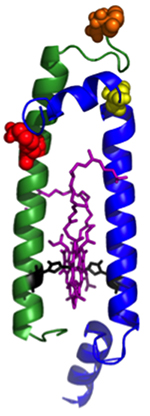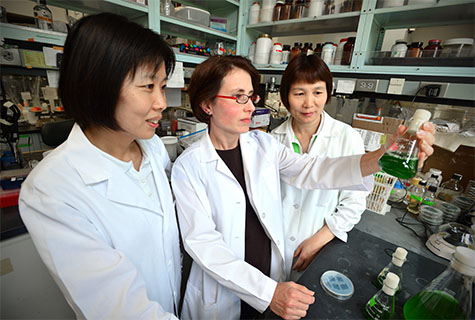
Ken Olsen
A sampling of weedy rice strains from an Arkansas rice field.
The evolutionary biologist Stephen Jay Gould once asked whether the living world would be different "if the tape were played twice." If there were a duplicate Earth evolving quietly beside ours, would we observe the emergence of creatures like ourselves and of plants and animals familiar to us, or would the cast of characters be entirely different?
It's an intriguing question.
So far replicate Earths are in short supply, but cases of parallel evolution (the same trait evolving independently in related lineages) allow scientists to ask some of the same questions.
One beautiful case of parallel evolution is the double domestication of rice in Africa as well as Asia, which was followed by its double "de-domestication," or reversion to a wild form, all within the roughly 10,000 years since hunter-gatherers became settled farmers.
With the help of modern genetic technology and the resources of the International Rice GeneBank, which contains more than 112,000 different types of rice, evolutionary biologist Kenneth Olsen, PhD, associate professor of biology in Arts & Sciences at Washington University in St. Louis, has been able to look back in time and ask whether the same mutations underlay the emergence of the same traits in both cultivated and weedy rice.
His latest findings, which take a close look at the genetics of hull color, appear in the July 17, 2013, online issue of the Journal of Evolutionary Biology.
The answers are interesting in their own right but also have practical importance because modern agriculture is radically changing the selection pressures acting on rice, the most important food crop for most of the world’s populations.
In response to these pressures, weedy forms that evolved from the crop forms are taking on traits more like those of wild ancestors. “They’re very aggressive competitors,” Olsen says, “and they’ve become a huge problem both here in the U.S. and all over the world.”
“In some parts of the world farmers have given up trying to grow rice and just market the weedy stuff that’s infested the fields as a health food,” he says. You sometimes see red rice from the Camargue, the delta region in southern France, in stores, he says. “Red rice is full of antioxidants, which tend also to be plant defense chemicals,” Olsen says, “but it is basically a weed.”

Ken Olsen
Rice fields in Arkansas. In the U.S., rice originally domesticated in Asia is grown in Arkansas, Louisiana, Mississippi, east Texas and California.
Double domestication
Worldwide, most of the cultivated rice is Asian rice, Oryza sativa which was bred from its wild progenitor Oryza rufipogon in southern Asia within the past 10,000 years.
Whether the familiar indica and japonica subspecies of Asian rice also represent independent domestications is controversial. Most of the rice grown in the U.S. is japonica rice, Olsen says, which is genetically pretty different from indica rice, the rice grown in a lot of the tropics.
In any event there was a second unambiguous domestication event about 3,500 years ago when African cultivated rice (O. glaberrima) was bred from the African wild species O. barthii in the Niger River delta.
Scientists are now in a position to examine the genetic basis of both the Asian and African domestications, Olsen says. In a way it’s like being able to go back to check DNA fingerprints at the scene of a crime committed well before DNA testing first became available.
When a plant is domesticated, it acquires a suite of traits called the domestication syndrome that made it easier to grow as a crop. In rice, the syndrome includes loss of shattering (the seeds don’t break off the central grain stalk before harvest), increase in seed size, and loss of dormancy (the seeds all germinate at once and can be harvested at once).
Do the same genetic mutations underlie the emergence of these traits in both the Asian and African domestication events, or did domestication result from different mutations in the same genes, or even from mutations in different genes?

Genevieve Hay
Olsen and postdoctoral research fellow Cindy Vigueira sample weedy rice in the WUSTL greenhouse for DNA extraction and analyses.
In a series of articles in the Journal of Evolutionary Biology and other journals, Olsen, postdoctoral researcher Cindy Vigueira, and their colleagues have shown that different mutations of the same genes underlie the loss of shattering, and the straw-colored hulls and white grains of both Asian and African cultivated rice.
So both Asian and African cultivated rice “broke” at roughly the same places under selection pressure from early farmers.
Double de-domestication
Like domestication, de-domestication, or evolution from the crop species of unpalatable weedy species that have many wild-like traits, also seems to have happened twice. One weedy strain resembles an Asian rice variety grown only in a small part of the Indian subcontient and the other strain resembles a rice grown in the tropics.
Because the weedy forms are closely related to rice varieties that were never grown in the U.S., they probably arrived as contaminants in grain stocks from Asia instead of evolving directly from the tropical japonica crops grown here.
The question, Olsen says, is whether crops reverted to wild forms by reversing the genetic changes that resulted in their domestication or through mutations that circumvented domestication in other ways.
At the genetic level the history of the weedy forms turns out to be messier than that of the crop forms.
For example, the weeds carry the crop form of the loss-of-shattering gene, which means that they branched off from the crops sometime after people selected for loss of shattering. The weedy forms shatter, but they’ve re-evolved this ability by some other, as yet unknown, pathway, he says.

Ken Olsen
Black-hulled weedy rice. Automated farming practices have made it much easier for weedy rice to escape notice and once it becomes established in a field, it can drive down the yield by 80 percent.
Weeds stealing crop genes
The most important part of this story, Olsen says, is that the genetic histories of the crops and the weeds are closely intertwined. This means the weedy forms can draw on both ancestral genes and crop genes as they respond to the selection pressures of modern agriculture.
Even though both weedy strains arose in Asia, he says, weedy rice became a problem in southeast Asia only in the last few decades. The reason is that rice seedlings were traditionally grown in paddies and then transplanted to the fields by hand. As they worked in the fields, farmers would recognize and pull weeds growing there.
But on industrialized farms, rice is sprouted directly in the field, so there’s no opportunity to remove weeds. Because the seedlings of both weedy and cultivated rice look alike, farmers often don’t realize they have a problem until the field is really infested.
Weedy infestations can drop the yield by as much as 80 percent, Olsen says. If a field is heavily infested, the farmer’s only recourse may be to abandon it.
In the U.S. weedy rice is increasingly combatted by growing herbicide resistant crop strains, Olsen says. In recent years more than a third of U.S. rice fields have been planted with herbicide-resistant rice.
But that places huge pressure on the weeds to acquire herbicide resistance by hook or by crook.
The mechanism of herbicide resistance that is bred into the crop is pretty simple, Olsen says. It’s basically a single amino-acid change in a particular gene, although newer varieties are getting a bit fancier and multiple genes may be involved. So it would be pretty easy for random mutations to confer resistance on the weeds.
The other possibility is that resistance genes will migrate from the crop to the weeds. Because both cultivated rice and weedy rice tend to self-fertilize, there hasn’t been a lot of gene flow going on in rice in general, Olsen says.
But the crop and the weeds — which are, after all, the same species – could easily hybridize now that selective pressure is favoring gene flow.
“We’re already seeing more and more hybridization occurring,” Olsen says. “It's going to change the overall composition of the weeds in U.S. rice fields and presumably elsewhere in the world as well.”

Ken Olsen
A field in front of a Riceland Foods storage facility in Stittgart, Arkansas, is infested with weedy rice, which stands taller than the other rice plants. Riceland, an agricultural marketing cooperative, is the world's largest miller and marketer of rice.















































